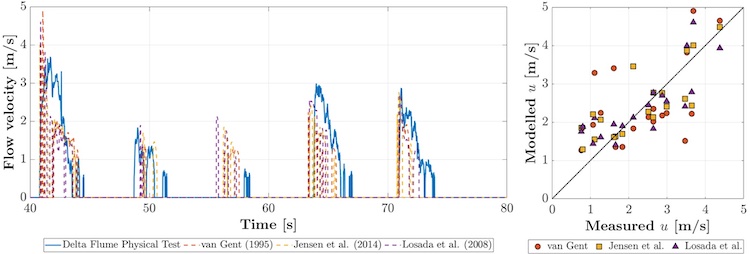L. Barendse1*, V.M. van Bergeijk1, W. Chen1, J.J. Warmink1, S.J.M.H. Hulscher1, A. Mughal2, D. Hill2
1 University of Twente,
2 Hillblock,
Introduction
Physical wave flume tests have been done at the Delta flume of Deltares to determine the flow velocities u [m/s] and pressures P [kPa] on the landward slope of the dike. The crest and landside slope have been covered with Grassblocks, blocks developed by Hillblock that are installed between the clay and grass cover of the dike to reduce further erosion when the grass cover has eroded. The blocks have a permeable function which reduces the flow velocity and pressures along the landward slope. The stability of the blocks needs to be determined in expensive flume tests where not all hydraulic parameters can be measured and only limited wave conditions and configurations can be tested. The goal of this study is to develop a hydrodynamic model for overtopping flow over porous blocks and to calculate the forces on these blocks.
Methods
The setup as used in the physical test has been implemented in OpenFOAM, a computational fluid dynamics software package. Using the solver porousWaveFoam which is included in the waves2Foam toolbox, a porous layer on the crest and landside slope has been implemented which represents the permeable function of the Grassblocks. The resistance force Fp of this porous layer depends on the resistance coefficients α [-] and β [-]. Then the model has been run using different combinations for α and β based on research by Van Gent (1995) [α=200, β=0.8], Jensen et al. (2014) [α=500, β=2.0] and Losada et al. (2008) [α=1000, β=1.1].
Results
The modelled peak values are compared with the measured peak values for both u and P. Fig. 1 shows the flow velocity, where the resistance coefficients of Losada et al. performed best with NSE = 0.68, followed up by Jensen et al. (NSE = 0.65) and Van Gent (NSE = 0.05). The calibrated model can then be used to determine the forces that occurred on the blocks during the physical test.

Figure 1: Measured and modelled peak values of flow velocity along the landside slope.
Acknowledgements
This research was funded by the Netherlands Organisation for Scientific Research (NWO), research programme All-Risk with project number P15-21.
References
Jensen, B., Jacobsen, N.G., & Christensen, E.D. (2014). Investigations on the porous media equations and resistance coefficients for coastal structures. Coastal Engineering, 84, 56–72.
Losada, I.J., Lara, J.L., & del Jesus, M. (2016). Modeling the interaction of water waves with porous coastal structures. Journal of Waterway, Port, Coastal and Ocean Engineering, 142(6).
Van Gent, M. R. A. (1995). Wave interaction with permeable coastal structures. Delft University Press.
I. Surname1*, F.N. Another-Surname2 , Y. Next-Surname2
1 University Name, Country; 2 Organization Name, Country
* Corresponding author: mail.name@organization.org


